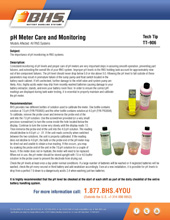We use cookies to make your experience better. To comply with the new e-Privacy directive, we need to ask for your consent to set the cookies. Learn more.
TT-906: pH Meter Care and Monitoring

Models Affected: All RNS Systems
The Importance of pH Monitoring in RNS Systems
Description:
Consistent monitoring of pH levels and proper care of pH meters are very important steps in assuring smooth operation, preventing part failures, and extending the overall life of your RNS system. Improper pH levels in the RNS holding tank account for approximately nine out of ten component failures. The pH level should never drop below 5.0 or rise above 9.0. Allowing the pH level to fall outside of these parameters may result in premature failure of the sump pump and float switch located in the battery wash cabinet. If left unchecked, further damage to the relief valve and system pump are likely. Also, highly acidic water may drip from recently washed batteries causing damage to your battery extractor, stands, and even your battery room floor. In order to ensure the correct pH readings are displayed during tank water testing, it is essential to properly maintain and calibrate the pH meter.
Recommendation:
BHS provides two different bottles of solution used to calibrate the meter. One bottle contains solution at 7.0 pH (P/N PB0805) and the other bottle contains solution at 4.0 pH (P/N PB0804). To calibrate, remove the probe cover and immerse the probe end of the unit into the 7.0 pH solution. Use the screwdriver provided (or a very small precision screwdriver) to turn the screw inside the hole located below the display. Continue to turn the screw very slowly until the display reads 7.0. Then immerse the probe end of the unit into the 4.0 pH solution. The reading should decline to 4.0 pH +/- .01. If the unit reads correctly when switched between the two solutions, the unit is properly calibrated. If the reading does not decline to 4.0 pH, the bulb on the probe end of the pH meter may be dried out and unable to obtain a true reading. If this occurs, you may try soaking the probe end of the unit in the 7.0 pH solution for a couple of hours. If the meter does not re-hydrate, the meter will need to be replaced. When not in use, the pH meter should be stored upright with 7.0 or 4.0 buffer solution in the probe cover to prevent the electrode from drying out. Check the pH levels at least once a day under normal conditions. If a large number of batteries will be washed or if neglected batteries will be washed, check the pH every second or third battery and add neutralizer accordingly. Even at a new installation, it is possible for pH levels to drop from a perfect 7.0 down to a dangerously acidic 3.4 when washing just two batteries.
It is highly recommended that the pH level be checked at the start of each shift as part of the daily checklist of the entire battery handling system.

